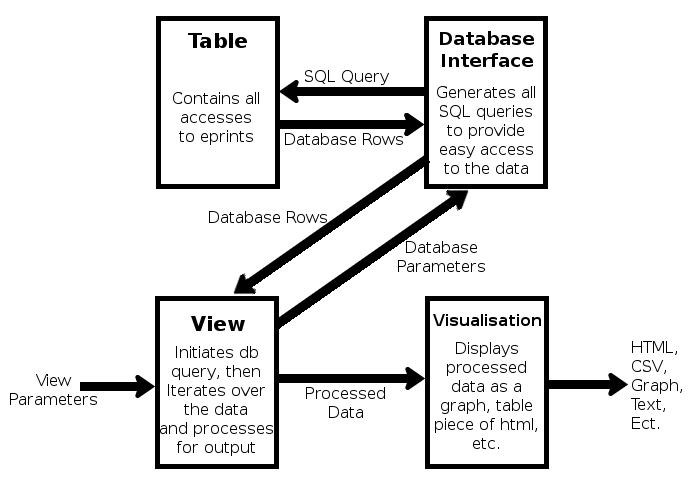Difference between revisions of "IRStats"
(→The Hits Table) |
(→The Text Files) |
||
| Line 48: | Line 48: | ||
=== The Text Files === | === The Text Files === | ||
| + | |||
| + | In order for IRStats to build up a picture of a repository, a number of text files need to be created and stored in the cfg/ directory: | ||
| + | |||
| + | * epstats_set_membership.txt | ||
| + | * epstats_set_member_codes.txt | ||
| + | * epstats_set_member_full_citations.txt | ||
| + | * epstats_set_member_short_citations.txt | ||
| + | * epstats_set_member_urls.txt | ||
| + | |||
| + | ==== Explanation by Example ==== | ||
| + | |||
| + | Imagine a very small repository. Here are its contents: | ||
| + | |||
| + | * eprints | ||
| + | ** (1) The Smells of Cheese | ||
| + | ** (2) The Tastes of Wines | ||
| + | ** (3) The Sounds of Oboes | ||
| + | * Authors | ||
| + | ** (1) John Smith | ||
| + | ** (2) Harriet Jones | ||
== Installing IRStats == | == Installing IRStats == | ||
Revision as of 13:19, 30 May 2007
IRStats is a flexible statistics package which allows easy processing of accesses to fulltext and abstract pages of eprints.
Contents
Technical Overview
The following is a quick tour of IRStats.
Parameters
IRStats output depends on four parameters, which need to be passed as cgi parameters if called through a web browser, or in a hash if called through the Perl API. These are:
Start Date and End Date
Date parameters are implemented as separate day, month and year parameters, so these two parameters are actually six (start_day, start_month, start_year, end_day, end_month, end_year). Any statistics outside this daterange are ignored.
An Eprint Set
As well as defining a daterange, we also have to inform IRStats of which publications we are interested in. Any publication not in the set will be ignored. A set of eprints can either be a single eprint or any set of eprints the system administrator wishes to define in the config files.
View
The final parameter tells IRStats how we want to process and display the statistics. This is done by selecting a View.
Views
Views are perl modules which plug in to IRStats. They have been designed to be user configurable, though some knowledge of perl is probably required. When a query is made to IRStats, a View is created. It generates some parameters for the DatabaseInterface object, which queries the database and passes back the results of the query. The View then iterates over the database rows and processes the stats in any way programmatically possible. These processed results are then passed to a Visualisation.
Visualisations
A Visualisation takes a set of processed statistics and outputs them. For example, Visualisation::Graph::Pie creates a pie chart.
The Database Interface
The Database Interface object handles all queries to the database. Most requests for statistics can be completed with a single call to the get_stats($params) method.
Data Flow Diagram
Required Data
In order for IRStats to run, it requires two things:
- a database table containing all hits to the repository
- text files describing the contents of the repository
The Hits Table
Awaiting a redevelopment.
The Text Files
In order for IRStats to build up a picture of a repository, a number of text files need to be created and stored in the cfg/ directory:
- epstats_set_membership.txt
- epstats_set_member_codes.txt
- epstats_set_member_full_citations.txt
- epstats_set_member_short_citations.txt
- epstats_set_member_urls.txt
Explanation by Example
Imagine a very small repository. Here are its contents:
- eprints
- (1) The Smells of Cheese
- (2) The Tastes of Wines
- (3) The Sounds of Oboes
- Authors
- (1) John Smith
- (2) Harriet Jones
